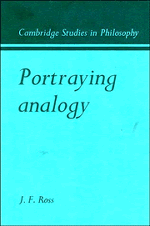Book contents
- Frontmatter
- Contents
- Dedication
- Preface
- Introduction
- 1 The limitations of classical analogy theory and the Miller's Analogies transition
- 2 The genus: meaning differentiation
- 3 Predicate schemes: an explanatory model
- 4 Equivocation, analogy and metaphor
- 5 Denominative analogy and paronymy
- 6 Figurative discourse
- 7 Analogy and religious discourse: craftbound discourse
- 8 Analogy and analysis
- Notes
- Bibliography
- Name index
- Subject index
1 - The limitations of classical analogy theory and the Miller's Analogies transition
Published online by Cambridge University Press: 07 October 2011
- Frontmatter
- Contents
- Dedication
- Preface
- Introduction
- 1 The limitations of classical analogy theory and the Miller's Analogies transition
- 2 The genus: meaning differentiation
- 3 Predicate schemes: an explanatory model
- 4 Equivocation, analogy and metaphor
- 5 Denominative analogy and paronymy
- 6 Figurative discourse
- 7 Analogy and religious discourse: craftbound discourse
- 8 Analogy and analysis
- Notes
- Bibliography
- Name index
- Subject index
Summary
The classical theory of analogy of meaning, analogia nominum, explained how same words are partly the same and partly different in meaning, ultimately and fundamentally, by appeal to relevant sameness and difference in the sorts of things to which the words are applied.
Analogous terms differ from merely equivocal terms (which are also to some degree and in some respects partly the same in meaning) because the sameness and the difference in the analogous meanings are not merely coincidental, not merely haphazard, a casu, but are a consilio, conventional. In a law-like way they reflect metaphysical similarities and differences of the referents, that are preserved as similarities and differences in the concepts abstracted from such things. Those similar but differing concepts are the meanings of the words that are analogous.
The classical account of analogy involved several distinct inquiries, only the first of which will be pursued here. To use medieval Latin terms, there is analogia nominum, ‘analogy of names’ or ‘analogy of meaning’, a phenomenon I take to be ubiquitous, indigenous and characteristic in natural languages. It is an obvious characteristic by which natural languages differ from artificial languages and the most evident strength through which natural languages expand to incorporate new ideas and by which the language performs some of our thinking for us. It is the phenomenon investigated and explained in this book.
There is also analogia rationis, ‘analogy of reason’, analogous thinking or reasoning; and there is analogia entis, ‘analogy of being’, analogy among things.
- Type
- Chapter
- Information
- Portraying Analogy , pp. 17 - 32Publisher: Cambridge University PressPrint publication year: 1982

